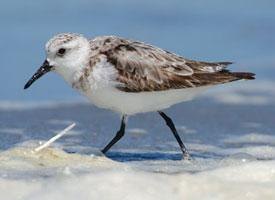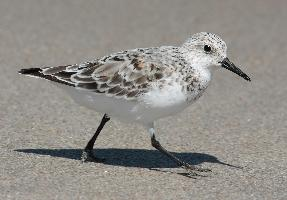
Descrierea animalului
The Red Phalarope (Phalaropus fulicarius), also known as the Grey Phalarope in Europe, is a small, distinctive wader belonging to the family Scolopacidae. This bird species is highly notable for its striking breeding plumage, unusual feeding behavior, and extraordinary migratory patterns, making it a subject of interest among birdwatchers and ornithologists alike.Description and Identification
Adult Red Phalaropes are about 7-8 inches (18-20 cm) in length, with a wingspan ranging from 16 to 17 inches (41 to 43 cm). They possess a compact, plump body shape with relatively short legs and a slender, needle-like bill that is slightly upturned. What sets the Red Phalarope apart, especially during the breeding season, is its vibrant plumage. Males, which are slightly duller, and females, who are more vividly colored (a reversal of the typical bird coloration pattern), both exhibit a striking combination of deep reddish-brown tones on the neck and upper chest, blending into a white belly. The face is adorned with a bold white patch, while the back features a mix of dark and light grey patterns. In contrast, their non-breeding (winter) plumage is primarily a sleek grey and white, making them less conspicuous.
Behavior and Ecology
Red Phalaropes are pelagic outside of the breeding season, spending most of their lives on the open ocean, far from land. This adaptation to marine life is reflected in their feeding behavior; they are often seen spinning in tight circles on the water's surface. This unique behavior creates a vortex, drawing small invertebrates such as crustaceans and plankton up to the surface, where the phalarope can easily pick them off. Their diet is mainly composed of these small aquatic creatures, although they will occasionally consume insects and larvae during the breeding season.
Breeding takes place in the Arctic regions of North America and Eurasia, where they favor tundra habitats near water. Red Phalaropes are ground-nesters, with the female laying a clutch of typically four eggs in a shallow scrape lined with vegetation. Unusually for birds, they exhibit a role reversal in parental duties; the females are more brightly colored and compete for males, who are responsible for incubating the eggs and raising the chicks.
Migration and Conservation
Red Phalaropes undertake long migratory journeys between their Arctic breeding grounds and their wintering areas in the tropical and subtropical oceans, including off the coasts of South America and Africa. Despite the vast distances traveled, they are relatively abundant and their populations stable, although they are susceptible to oil spills and pollution, given their marine lifestyle.
Conclusion
The Red Phalarope is an extraordinary bird, not just in appearance but in its unique behaviors and life cycle. Its adaptation to a pelagic existence, role reversal in breeding, and extensive migratory patterns underscore the diversity and complexity of avian life. While not currently considered at risk, the preservation of their oceanic and Arctic habitats is essential for ensuring the continued survival of this fascinating species.
Animale similare
Fotografii noi cu animale
Top 10 animale
- Dolphin gull (Leucophaeus scoresbii)
- Diana monkey (Cercopithecus diana)
- Moustached guenon (Cercopithecus cephus)
- Stone loach (Barbatula barbatula)
- Greek tortoise (Testudo graeca)
- Galápagos tortoise (Geochelone nigra complex)
- Japanese macaque (Macaca fuscata)
- Russian tortoise (Testudo horsfieldii)
- Common flying dragon (Draco volans)
- Galápagos penguin (Spheniscus mendiculus)


